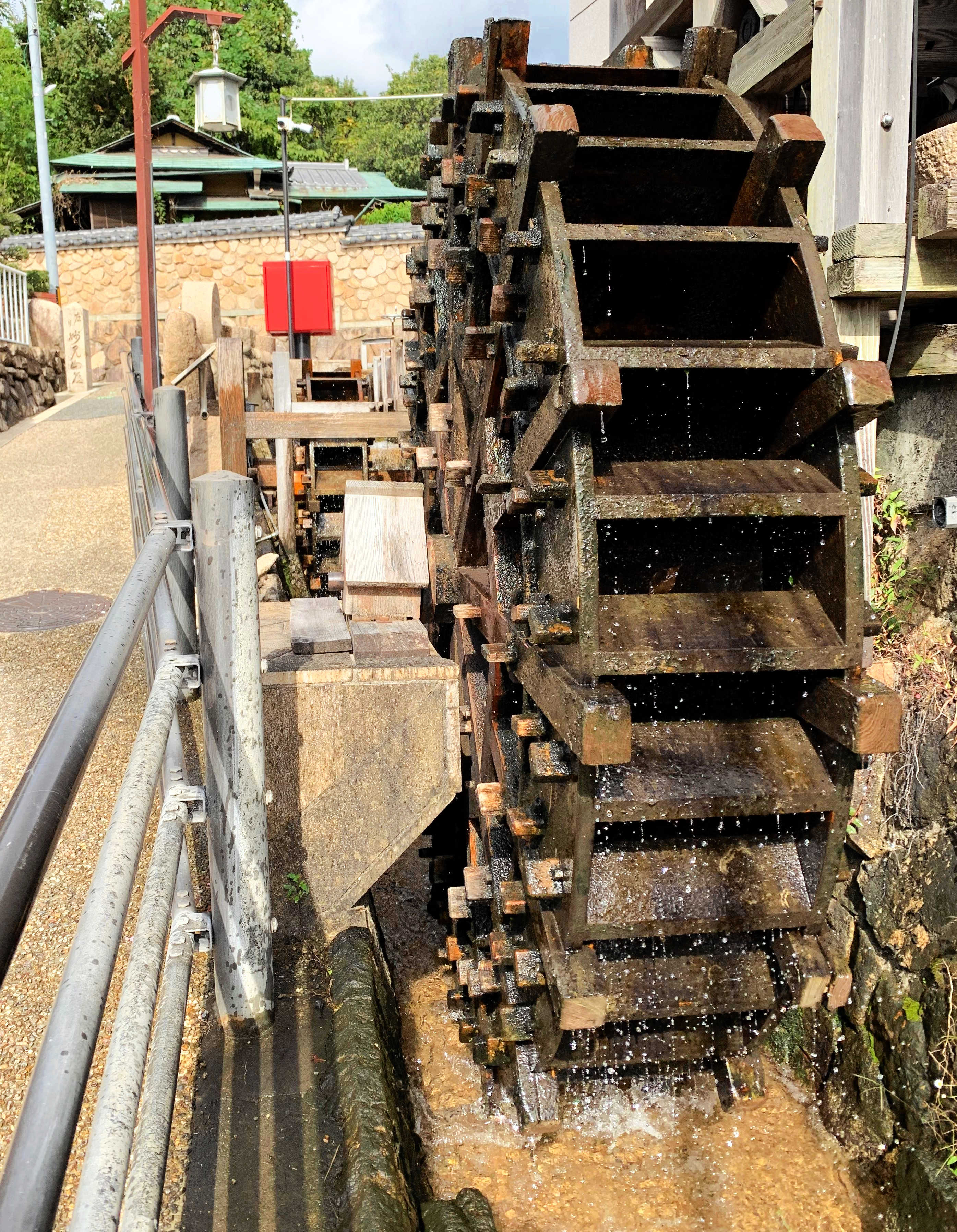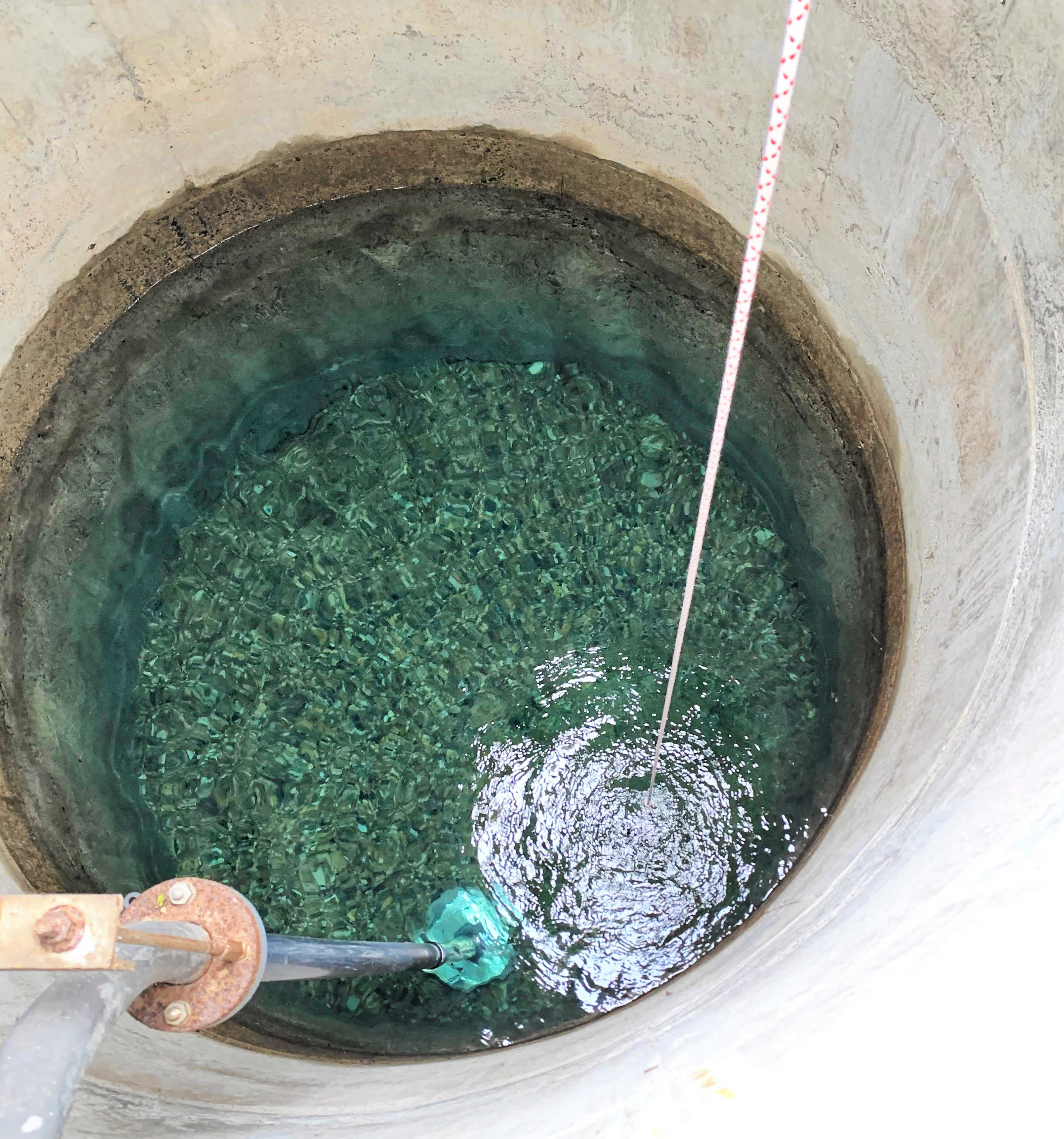Blessings of Mt. Rokko: “Miracle Water” from Nadagogo
A concept commonly used to describe the various environmental factors that determine the taste and aroma of wine and tea is water. This raw material is also an essential compound in making sake.
The water wheel industry and economic growth
.jpg)
First, taking a look at a map of the local geology, locations in light green, such as the basins of the Tojo River (Kato City) and the Mino River (Miki City), belong to the Kobe Group, which includes the ‘Special A District’, popular among brewers for Yamada Nishiki. To the south, the area in pink that extends from east to west is a stratum of granite that extends from Mt. Rokko to Awaji Island. It is said to have been formed around 70 to 80 million years ago, during the age of the dinosaurs, when an underground magma chamber cooled and solidified, mostly located more than 10 kilometres underground. But for some reason, this deep stratum emerged from the mountain surface at over 900 metres high. Shigehiro Kato, a senior researcher at the Hyogo Prefectural Museum of Nature and Human Activities, explained that “during the last million years, there has been underground fault activity that has caused it to rise continuously, and all the strata in more recent eras, such as the Kobe Group, were pushed away, creating the steep granite mountains we see today. Mt. Rokko is still a young mountain, and it continues to rise today.” A number of rapid rivers were also created around these steep mountains that emerged due to the earth’s dynamic activities. Nadagogo, Japan’s number one sake producing area, started out by harnessing the power of the river water in its water wheels.
At the beginning of the Edo period, on the south side of Mt. Rokko, water wheels were operated to extract oil for lighting from rapeseed and other crops. Eventually, water wheels were also used in sake brewing to polish the surface of the rice. Visitors to the area can feel the power of water and how it has been mastered by humans while walking along the ‘Seiryu-no-michi’ hiking path that skirts the riverside of the Sumiyoshi River (Higashinada Ward, Kobe City), one of the Rokko Mountain’s largest rivers and one that continues to have strong water flow today.
The water that springs from the Rokko Mountains, whose highest peak reaches 931 metres, cascades down riverbeds with endless steps like a long staircase and flows like a waterfall to join the sea some 5 kilometres away. A little south from the Hakutsuru Museum that is located upstream, visitors to the area can find the restored ‘Nadame Waterwheel’ along the waterway.

‘Nadame water wheel’ restored in the waterway of the Sumiyoshi River basin = Higashinada Ward, Kobe City
Masao Uchida, curator of the Sumiyoshi Historical Museum, told us about the days when rice was milled using waterpower explaining how “the water wheel was located inside a building, and various equipment was attached to it, creating something similar to a large factory”. He also explained what made Mt. Rokko water wheels unique. A total of approximately 100 pestles and mortars were installed on both sides of the huge water wheel, and rice was polished 24 hours a day. It is said that there were as many as 10,000 mortars being used in the Sumiyoshi River water mills alone at the time. At a time when rice was milled manually, waterpower being introduced as a renewable energy source contributed to technological innovation in the area. The high-quality raw rice that was polished by watermills spread across the rivers of the Rokko Mountains (Ikuta River, Toga River, Ishiya River, Sumiyoshi River (Kobe City), Ashiya River (Ashiya City)) was transported to the ever-increasing number of sake breweries in Hyogo’s coastal areas. High-quality sake, which could now be mass-produced, was transported to Edo (modern day Tokyo) by sailing ships and came to account for 70 to 90 percent of the entire market. The Edo shogunate, noticed the economic power of an industrial city powered by a renewable energy source, and decided to designate this area a fief under their direct control.
The water wheel powered industry that developed at the foot of Mt. Rokko reached its peak during the Meiji (1868-1912) and Taisho periods (1912-1925) but declined with the spread of electricity. Most of the water wheels were washed away and destroyed in the Great Hanshin Flood of 1938. Uchida also shared how “the south side of Mt. Rokko, where various jobs were created with the water wheel industry at its core, was an advanced economic region. The history of if these water wheels were at the foundation of development at the time and deserve our attention.”
An exquisite blend
Another blessing of Mt. Rokko's rapids is the quality of the water. The groundwater that permeates through the granite strata and continues to flow for over 400 to 600 years is medium-hard water and is rich in calcium and magnesium. The hardness of this water falls somewhere between the soft water that Japanese people tend to prefer and the hard water that is common in mineral water in Europe and America. Takeyuki Konishi, head of the quality assurance department who manages sake brewing water at Hakutsuru Sake Brewery (Higashinada Ward, Kobe City), spoke passionately about the appeal of this famous water (known as “miyamizu”), which is praised as ideal for making sake, explaining that “while it is rich in phosphorus and potassium, which are essential for yeast fermentation, it is low in iron, which can add an unwanted colour and odour to sake.”
The quality of Rokko's famous water continues to be maintained through efforts to protect it from the effects of rapid development between Hyogo and Osaka, and it continues to be used as an important raw material for sake making.
In the Kobe area of Nadagogo, when underground construction is being carried out for apartments, railways, etc., the Sake Brewers Association’s ‘Water Resource Committee’ discusses measures with the developers to avoid negative effects on local groundwater. They are also active in research, and in 1973 in order to achieve stable water resources for the future, a water supply system exclusively for sake brewing was established, sourcing water from the upper reaches of the Sumiyoshi River.
Another symbol of Nadagogo’s sake brewing water is ‘Miyamizu’ from Nishinomiya. The quality of the well water has been preserved thanks to the above organization creating the Miyamizu Preservation Investigation Committee, established in 1924. For many years, the quality of Miyamizu has been maintained through an exquisite blend of three types of underground water, gaining it the moniker of “miracle water.”
.jpg)
The Miyamizu wells of each sake brewery are concentrated in an area to the southeast of Nishinomiya Shrine. The ‘Hoanji’ underground flow from the northeast and the ‘Fudabasuji’ underground flow from the north pass through what used to be the sea in the Jomon period (approx. 14,500-300 BC), so they are rich in minerals, including iron which has a negative impact on sake. This high iron content is transformed into iron oxide by the oxygen contained in the fast-flowing Ebisu underground flow from the Shukugawa River and is removed naturally. Taking a look at the Miyamizu Well in Ozeki (Nishinomiya City), which is located in a quiet residential area, reveals a shallow well, less than 3 meters from the ground lined with gravel. The water has a refreshing colour that belies water from an urban area.

Ozeki Miyamizu, well with gravel clearly visible at the bottom = Miyamizu Garden, Ishizai-cho, Nishinomiya City
Masaya Kinumi, Ozeki’s quality assurance manager explained how “during comprehensive water sampling carried out twice a year, wells in private homes as well as wells in other warehouses are checked for abnormalities occurring in the water throughout the area”. In 2017, Nishinomiya City enacted the Miyamizu Conservation Ordinance, which requires application for permission prior to construction.
Miyamizu, which is close to the sea, is susceptible to contamination by seawater if underground water ways weaken due to development. Because of this, sourcing has continued to move north. All involved hope that this miracle water that has been used to produce fine sake throughout the ages will continue to be passed down to the next generation.
Written by Kazuyoshi Tsujimoto, Manager of Corporate Planning Department, Senior Staff Writer at The Kobe Shimbun (Daily Newspaper)
This article was first published on 31st October 2021 in The Kobe Shimbun as part of a series entitled "Wind, Water and Earth...Hyogo's Terroir"
Date : 2024.05.29



